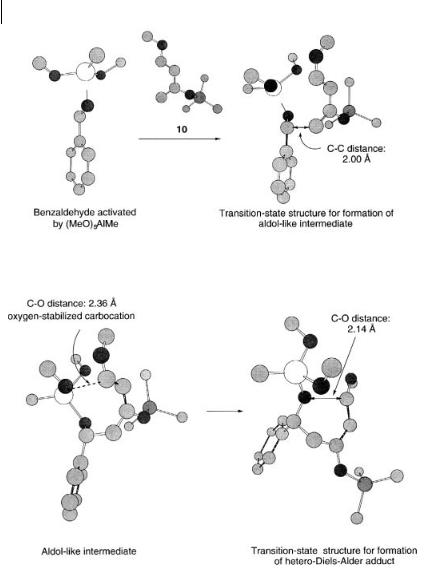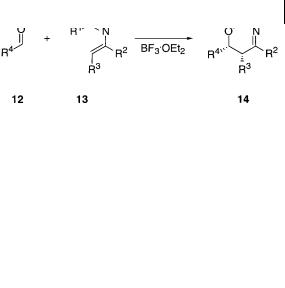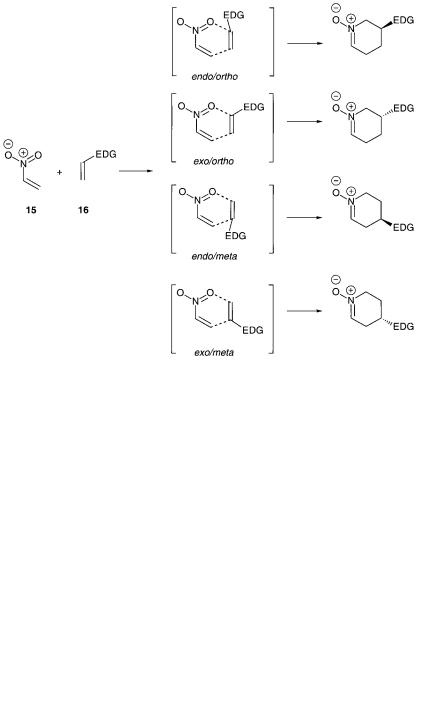
Cycloaddition Reactions in Organic Synthesis
.pdf
8.2 Carbo-Diels-Alder Reactions 311
the pseudo-axial phenyl group of the chiral ligand which seems to shield one of faces of the cinnamoyloxazolidinone and this model has been proposed to account for the enantioselection of the both the carbo-Diels-Alder and 1,3-dipolar cycloaddition reactions catalyzed by these complexes [17]. However, Seebach et al. [18] and DiMare et al. [19] have suggested that, although complex A is the major intermediate in solution, the minor intermediates, B1 and B2, in which the enoate moiety is in the trans position with the chloride ligands, have a higher degree of Lewis acid-activation, and hence to be the most reactive intermediate.
In an attempt to obtain insight into the intermediate for these TADDOL-Ti(IV)- catalyzed carbo-Diels-Alder reactions Mayoral et al. [20] have performed a series of ab-initio calculations of the model complexes A–C shown in Fig. 8.8. They used model complexes formed between 3-acroloyl-1,3-oxazolidin-2-one and an achiral analog of TADDOL-TiCl2, namely that derived from 1,4-butanediol MA-MC (Fig. 8.9). The geometries of MA-MC were optimized and some data are shown in Fig. 8.9. For MA the data obtained for X-ray structure of A shown in the brackets and it appears that the calculated results are in good agreement with the experimental results. The most stable complex was calculated to be MA in accordance with the experimental results [16–19]. Complex MC is the next most stable complex, but with a difference of more than 5 kcal mol–1 with respect to MA. Finally, MB is the most unstable complex, although it is close in energy (1–2 kcal mol–1) to MC. In order to account for the reactivity of MA-MC the LUMO energy of each complex has been calculated. The LUMO, which essentially corresponds to the * MO of the , -unsaturated carbonyl moiety of the dienophile exhibits a strong polarization towards the carbonyl carbon atom as expected from the coordination to the Lewis acid. The lowest LUMO energy is that of MB followed by MC and MA, the LUMO energy difference between MB and MA is ca. 4 kcal mol–1 (< 0.2 eV) and is basis-set dependent. The charge transfer from the dienophile to the titanium complex gave for MA 0.144 electrons, while 0.162 and 0.148 were obtained for MB and MC, respectively. Mayoral et al. [20] concluded on the basis of the theoretical calculations, that MB experiences the highest degree of Lewis acid-activa- tion by the TADDOL-TiCl2 complex, which is in line with the LUMO energy values and that intermediate MB, which exists in small concentrations under the reaction conditions is responsible for the reaction course of these carbo-Diels-Alder reaction. However, at the present it has not been clearly confirmed whether or not the trans and/or cis complex(es) are real reactive intermediates.
Several papers have been using theoretical calculations at various levels of sophistication for different types of Diels-Alder reactions and often in relation to experimental investigations. Branchadell et al. [21] have investigated the effect of AlCl3 on the reaction of (Z)-(S)-4,5-(2,2-propylidenedioxy)pent-2-enoate and (Z)-(S)- 4,5-(2,2-propylidenedioxy)pent-2-enoate acid with cyclopentadiene (Scheme 8.3) at the B-LYP/6-31G* level of calculations. The transition state for the latter reactions has been calculated to have the lowest energy barrier of 14.6 kcal mol–1 in qualitative agreement with the experimental results. The effect of AlCl3 on the endo-exo selectivity can be attributed to both steric and electronic effects. The latter relates to the complexation of the enoate molecule to the catalyst favoring an s-trans con-

312 8 Theoretical Calculations of Metal-catalyzed Cycloaddition Reactions
The calculated model complexes formed between 3-acroloyl-1,3-oxazolidin-2- one and an achiral analog of TADDOL-TiCl2,
namely that derived from 1,4-butanediol MA–MC [20]. The number in the brackets refer to data obtained for X-ray structure [16]
formation of the ester moiety which leads to an increase of the stabilizing interactions favoring the endo transition state. The syn-anti selectivity has been found to be due to steric effects. The transition-state structures for this reaction also show the asynchronous reaction course.
Scheme 8.3
The reaction of methyl vinyl ketone with furan catalyzed by BF3 was studied by Babiano et al. [22]. The transition states predicted were also relatively concerted and highly asynchronous for all the reaction paths studied.

8.2 Carbo-Diels-Alder Reactions 313
Yamamoto et al. have developed a catalytic enantioselective carbo-Diels-Alder reaction of acetylenic aldehydes 7 with dienes catalyzed by chiral boron complexes (Fig. 8.10) [23]. This carbo-Diels-Alder reaction proceeds with up to 95% ee and high yield of 8 using the BLA catalyst. The reaction was also investigated from a theoretical point of view using ab-initio calculations at a RHF/6-31G* basis set. The four different transition states in Fig. 8.10 were considered with BF3 as a model for the BLA catalyst in the theoretical calculations. It was found that the lowest transition-state energy for the BF3-catalyzed reactions was calculated to be 21.3 kcal mol–1 for anti-exo transition state, while only 1.5 kcal mol–1 higher in energy the syn-exo transition state, was found. The uncatalyzed reaction was calculation to proceed via an exo transition state having an energy of 37.0 kcal mol–1. The calculations indicated that the reaction proceeds predominantly by an exo transi- tion-state structure and that it is enhanced by the coordination of the Lewis acid. The transition-state structures were also found to be more asynchronous in the presence of BF3 Lewis acid compared with the uncatalyzed reactions.
A series of investigation using, e.g., semi-empirical calculations have also been performed [24]. These calculations are often used in relation with experimental investigations, as well as, e.g., the carbo-Diels-Alder reaction of acrolein with dienes.
We are now able to understand the Lewis acid-catalyzed normal electron-de- mand carbo-Diels-Alder reaction from a theoretical point of view. The calculated influence of the Lewis acids on the reaction rate, regioand stereoselectivity in an
Fig. 8.10 The catalytic enantioselective carbo- |
boron complexes (BLA) and the transition-state |
Diels-Alder reaction of acetylenic aldehydes 7 |
structures investigated by ab-initio calculations |
with cyclopentadiene 2 catalyzed by chiral |
[23] |

314 8 Theoretical Calculations of Metal-catalyzed Cycloaddition Reactions
exo–endo sense , -unsaturated carbonyl compound with cyclopentadiene fits nicely the experimental results. The calculations indicate that the carbo-Diels-Alder reactions are still “concerted-like” – however, the presence of the Lewis acid makes the transition-state structures more asynchronous compared to the uncatalyzed reactions.
8.3
Hetero-Diels-Alder Reactions
8.3.1
Frontier-molecular-orbital Interactions for Hetero-Diels-Alder Reactions
Hetero Diels-Alder reactions can also be classified into two types of [ 2s + 4s] cycloadditions, the normal and inverse electron-demand hetero-Diels-Alder reactions, based on the relative energies of the FMOs of the diene and the dienophile (Fig. 8.11) [1 b].
The normal electron-demand reaction is a HOMOdiene-LUMOdienophile-controlled hetero-Diels-Alder reaction which predominantly occurs between electron-rich dienes and electron-deficient dienophiles (Fig. 8.11, left – dotted line). The inverse electron-demand hetero-Diels-Alder reaction is primarily controlled by a LUMOdiene-HOMOdienophile interaction which can be found for e.g. enones and heteroanalogs reacting with alkenes having electron-donating groups (Fig. 8.11, right – dotted line).
The basic concept of activation in hetero-Diels-Alder reactions is to utilize the lone-pair electrons of the carbonyl and imine functionality for coordination to the Lewis acid. The coordination of the dienophile to the Lewis acid changes the FMOs of the dienophile and for the normal electron-demand reactions a decrease of the LUMO and HOMO energies is observed leading to a better interaction with
Fig. 8.11 An FMO diagram of the normal |
der reactions, in the absence and presence of a |
and inverse electron-demand hetero-Diels-Al- |
Lewis acid |

8.3 Hetero-Diels-Alder Reactions 315
the dienophile (Fig. 8.11, left – full line). The energy difference between the HOMOdiene and the LUMOdienophile is thus reduced compared with the absence of a Lewis acid which can account for the activating effect of the Lewis acid. The catalytic properties of the Lewis acid for the inverse electron-demand hetero-Diels-Al- der reaction is due to the coordination of the Lewis acid to a heteroatom of the 1,3-diene leading to a decrease of the LUMOdiene and HOMOdienophile energies, and thus, based on a FMO way of reasoning, a more favorable interaction with the electron-rich alkene takes place (Fig. 8.11, right – full line). Furthermore, the coordination to the Lewis acid alters also, to some extent, the distribution of the atomic orbital coefficients of the dienophile and the 1,3-diene. For a carbonyl compound an increase in the magnitude of the LUMO atomic orbital coefficient at the carbonyl carbon atom is observed making it more susceptible to the diene. However, this polarization may also influence on the reaction mechanism. It has been pointed out that the hetero-Diels-Alder reaction can change from a concerted non-synchronous mechanism to a stepwise mechanism depending on the substituents on the reacting species and reaction conditions.
Very few theoretical studies of hetero-Diels-Alder reactions have been performed [25] and, furthermore, theoretical studies of the Lewis acid-catalyzed hetero-Diels- Alder reactions are even more limited.
8.3.2
Normal Electron-demand Hetero-Diels-Alder Reactions
The transition-state structure of the hetero-Diels-Alder reaction is generally found to be unsymmetrical. Houk et al. have for the reaction of formaldehyde with 1,3- butadiene calculated the C–C and C–O bond lengths to be 2.133 Å and 1.998 Å, respectively, in the transition state using ab-initio calculations shown in Fig. 8.12 [25 b]. The reaction of formaldimine follows the same trend for the transition-state structure.
The hetero-Diels-Alder reaction of formaldehyde with 1,3-butadiene has been investigated with the formaldehyde oxygen atom coordinated to BH3 as a model for a Lewis acid [25 b]. Two transition states were located, one with BH3 exo, and one endo, relative to the diene. The former has the lowest energy and the calculated transition-state structure is much less symmetrical than for the uncatalyzed reaction shown in Fig. 8.12. The C–C bond length is calculated to be 0.42 Å longer, while the C–O bond length is 0.23 Å shorter, compared to the uncatalyzed reac-
Fig. 8.12 Calculated transition-state structure for the hetero-Diels-Alder reaction of formaldehyde with butadiene [25 b]

316 8 Theoretical Calculations of Metal-catalyzed Cycloaddition Reactions
tion. The transition state of the Lewis acid-catalyzed reaction has significant zwitterionic character, with a partial positive charge of 0.37 on the diene and a negative charge on the formaldehyde oxygen atom of –0.65 and –0.28 on BH3. The coordination of the carbonyl oxygen atom to BH3 makes the carbonyl group an acceptor of negative charge, and the O–B bond length in the transition state is 0.12 Å shorter compared with the BH3–formaldehyde complex, indicating a tighter complexation in the transition state.
By coordination of the formaldehyde oxygen atom to BH3 the activation energy of the reaction with 1,3-butadiene drops considerably. This is in agreement with the experimental results, since Lewis acid catalysis in general are required for reactions of carbonyl dienophiles to proceed [26] and/or are found to enhance the reaction rate. Houk et al. have found that, at the highest level of calculations (MP2/6-31G*), the activation energy is 8.9 kcal mol–1, which is 12.0 kcal mol–1 lower in energy than the uncatalyzed reaction [25b]. The calculations indicate that the exo position is favored due to the greater electrostatic repulsion between BH3 and butadiene fragment in the endo transition-state structure.
The mechanism for the hetero-Diels-Alder reaction of benzaldehyde 9 with the very reactive diene, Danishefsky’s diene 10, catalyzed by aluminum complexes has been investigated from a theoretical point of view using semi-empirical calculations [27]. The focus in this investigation was to address the question if the reaction proceeds directly to the hetero-Diels-Alder adduct 11, or if 11 is formed via a Mukaiyama aldol intermediate (Scheme 8.4) (see the chapter dealing with hetero- Diels-Alder reactions of carbonyl compounds).
Scheme 8.4
The reaction was studied in the absence, and presence, of (MeO)2AlMe as a model catalyst for the BINOL-AlMe system. The change in relative energy for the concerted hetero-Diels-Alder reaction, and formation of the hetero-Diels-Alder adduct 11 via a Mukaiyama aldol reaction, is shown in Fig. 8.13. The conclusion of the study was that in the absence of a catalyst the concerted reaction is the most

Fig. 8.13 Schematic representation of the change in energies for the concerted hetero- Diels-Alder reaction of benzaldehyde with Danishefsky’s diene and the step-wise reaction
8.3 Hetero-Diels-Alder Reactions 317
in the presence of (MeO)2AlMe as the Lewis acid. Energies (kcal mol–1) are relative to the total energy of the starting compounds [27]
likely one with a transition-state energy of 27 kcal mol–1, while for the reaction catalyzed by (MeO)2AlMe, a two-step mechanism is found with a transition-state energy of 13 kcal mol–1 for the first step (the C–C bond being formed) leading to the Mukaiyama aldol intermediate, followed by a 5 kcal mol–1 transition-state energy for the ring-closure step. The aldol intermediate seems to be stabilized by an interaction of the cation with the oxygen atom of the Lewis acid.
The structures along the reaction path in Fig. 8.13 are outlined in Fig. 8.14 starting with benzaldehyde activated by (MeO)2AlMe in the reaction with Danishefsky’s diene 10 leading to the transition-state structure for the formation of the al- dol-like intermediate, and finally the formation of the hetero-Diels-Alder adduct.

318 8 Theoretical Calculations of Metal-catalyzed Cycloaddition Reactions
Fig. 8.14 The calculated transition-state structures along the reaction path for the step-wise formation of the hetero-Diels-Alder
adduct 11 by reaction of benzaldehyde with Danishefsky’s diene 10 [27]
The hetero-Diels-Alder reaction of aldehydes 12 with 2-azabutadienes 13 (Scheme 8.5) has been studied using high-level ab-initio multiconfigurational molecular orbital and density functionality calculation methods [28].
To determine the preferred pathway for the [4 + 2]-hetero-Diels-Alder reaction model reactions using formaldehyde (R4 = H for 12 in Scheme 8.5) as the carbonyl compound and 2-azabutadiene (R1–R4 = H for 13 in Scheme 8.5) for the hetero

8.3 Hetero-Diels-Alder Reactions 319
Scheme 8.5
Fig. 8.15 Calculated transition-state structure for the
[4 + 2] hetero-Diels-Alder reaction of formaldehyde with 2- azabutadiene [28]
diene. Both the concerted and stepwise reaction paths were calculated and the lowest energy transition-state structure for the uncatalyzed reaction is presented in Fig. 8.15 [28]. The basic feature for this transition-state structure is similar to those of transition-state structure located for similar reactions and show limited asynchronicity and the bond lengths being formed of about 2.0 Å. The three carbon atoms being involved in the bond formations are significantly pyramidalized.
The calculated |
transition |
state energy for the uncatalyzed reaction is 17.2– |
47.6 kcal mol–1 |
depending |
on the basis set used. The transition state energy for |
the formation of the other regioisomer, and a step-wise reaction path, were found to be located higher in energy.
The transition state for the BH3-catalyzed reaction was also found. The favored regioisomer and the influence of the Lewis acid on the reactivity was accounted for by a FMO-way of reasoning using as outlined in Fig. 8.11 to the left. The coordination of BH3 to formaldehyde was calculated to lower the LUMO energy by 1.6 eV compared to formaldehyde, thus increasing the total charge transfer in the transition-state structure, which is calculated to be 0.377 at a RHF/6-31G* level of calculations. The presence of BH3 as the Lewis acid for the reaction significantly increases the asynchronicity of the transition-state structures. For the exo transi- tion-state structure, which has the lowest energy of the different transition-state structures located, the C–O and C–C bond lengths are calculated to be 2.368 and 1.904 Å, respectively, using the RHF/6-31G* basis set. The calculated transitionstate structure energy for the BH3-calculated reaction is calculated to be 8.1 kcal - mol–1 at a Becke3LYP/6-31G* level of calculations, compared to 17.2 in the case of the uncatalyzed reaction. For this hetero-Diels-Alder reaction the theoretical results are in nice agreement with the experimental results [28].

320 8 Theoretical Calculations of Metal-catalyzed Cycloaddition Reactions
8.3.3
Inverse Electron-demand Hetero-Diels-Alder Reactions
The final class of reactions to be considered will be the [4 + 2]-cycloaddition reaction of nitroalkenes with alkenes which in principle can be considered as an inverse electron-demand hetero-Diels-Alder reaction. Domingo et al. have studied the influence of reactant polarity on the reaction course of this type of reactions using DFT calculation in order to understand the regioand stereoselectivity for the reaction, and the role of Lewis acid catalysis [29]. The reaction of e.g. nitroethene 15 with an electron-rich alkene 16 can take place in four different ways and the four different transition-state structures are depicted in Fig. 8.16.
For the uncatalyzed reactions the calculations showed that the ortho approaches were favored over the meta, and the endo selectivity was the energetic most favorable reaction paths for most of the electron-donating substituents studied [29]. The endo- ortho reaction path is under FMO control and the substituent effect on the regioselectivity was explained for by a dominant interaction between LUMOdiene and HOMOdienophile. The ortho reaction path was investigated with BH3 as the Lewis acid and it was calculated that the presence of Lewis acid decreases the activation
Fig. 8.16 The different approaches of an alkene substituted with an electron-donating group (EDG) to nitroethene
